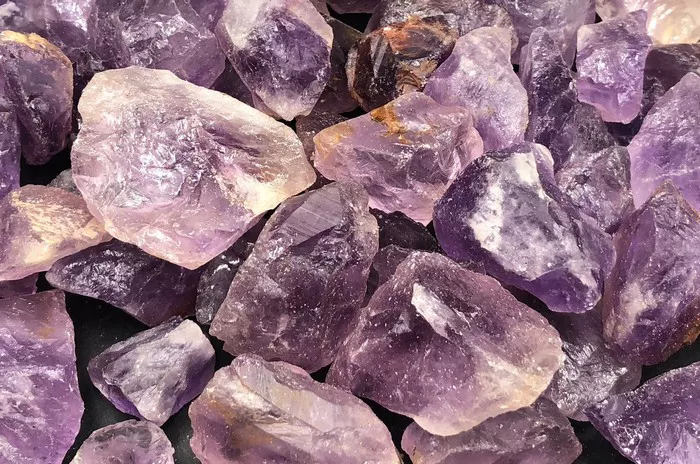Amethyst, with its enchanting purple hues and mystical allure, is a beloved gemstone treasured by collectors, jewelry enthusiasts, and spiritual practitioners alike. While the cost of raw amethyst can vary depending on factors such as size, quality, and origin, understanding the pricing dynamics can help buyers make informed decisions. In this article, we’ll explore the factors influencing the cost of raw amethyst and provide insights into its pricing in the gemstone market.
Introduction to Raw Amethyst
Raw amethyst, also known as rough amethyst or uncut amethyst, refers to amethyst crystals in their natural, unprocessed state. Unlike polished and faceted gemstones, raw amethyst retains its natural shape, texture, and crystal formations, showcasing the raw beauty of the gemstone. Raw amethyst is typically extracted from the earth through mining processes and is then cleaned and sorted before being cut and polished into finished gemstones or used in jewelry.
Amethyst is a variety of quartz, a mineral composed of silicon and oxygen atoms arranged in a tetrahedral lattice structure. The purple color of amethyst is due to the presence of trace amounts of iron within the crystal lattice. The intensity and shade of purple can vary widely, ranging from pale lilac to deep violet, with some specimens exhibiting zoning or color banding.
Factors Affecting the Cost of Raw Amethyst
Several factors influence the cost of raw amethyst, including the following:
Size: The size of a raw amethyst crystal is one of the most significant factors determining its price. Larger crystals are rarer and thus more valuable than smaller specimens. However, the price per gram or per carat tends to decrease as the size of the crystal increases, as larger crystals yield more material for cutting and polishing into finished gemstones.
Quality: The quality of raw amethyst is determined by factors such as color, clarity, and transparency. Deep, vibrant purple colors with excellent saturation are highly prized and command higher prices in the market. Stones with good clarity and transparency, free from significant inclusions or fractures, are also more valuable than those with visible internal characteristics.
Origin: The geographic origin of a raw amethyst crystal can significantly affect its value and desirability. Certain sources are known for producing amethyst crystals with specific colors, characteristics, and quality. For example, amethysts from Uruguay are prized for their deep, saturated purple hues and exceptional clarity, while Brazilian amethysts are known for their rich, reddish-purple colors and unique crystal formations.
Crystal Form: The natural crystal form and shape of a raw amethyst specimen can influence its value and appeal. Well-formed crystals with distinct terminations, symmetry, and clarity are highly sought after by collectors and enthusiasts. Specimens with unique formations, such as cathedral or scepter crystals, may command premium prices due to their rarity and aesthetic appeal.
Market Demand: Market demand and trends can also impact the price of raw amethyst. Fluctuations in demand from jewelry designers, collectors, and consumers can affect prices in the gemstone market. Factors such as cultural influences, fashion trends, and the popularity of metaphysical properties may influence the demand for raw amethyst and its pricing.
How Much Does Raw Amethyst Cost
The price of raw amethyst can vary widely depending on the factors mentioned above. In general, raw amethyst is more affordable than polished and faceted gemstones, making it an attractive option for collectors and enthusiasts on a budget. However, prices can range from a few dollars per gram for smaller, lower-quality specimens to hundreds or even thousands of dollars per gram for larger, high-quality crystals.
At the lower end of the price spectrum, smaller raw amethyst crystals with pale or light purple colors may be relatively inexpensive and readily available. These specimens are often used by hobbyists, artisans, and metaphysical practitioners for crafting, meditation, and decorative purposes.
On the other hand, larger and higher-quality raw amethyst crystals with deep, vibrant purple colors and exceptional clarity can command premium prices in the market. These specimens are highly prized by collectors, jewelry designers, and enthusiasts for their beauty, rarity, and investment potential. Unique formations, such as cathedral or scepter crystals, may also fetch higher prices due to their rarity and aesthetic appeal.
Conclusion
In conclusion, the cost of raw amethyst can vary widely depending on factors such as size, quality, origin, crystal form, and market demand. While smaller and lower-quality specimens may be relatively affordable and accessible, larger and higher-quality crystals can command premium prices in the market. Whether you’re a collector, jewelry designer, or enthusiast, understanding the pricing dynamics of raw amethyst can help you make informed decisions when purchasing or investing in this captivating gemstone. With its timeless beauty, rich symbolism, and spiritual significance, raw amethyst continues to captivate and inspire people around the world.


